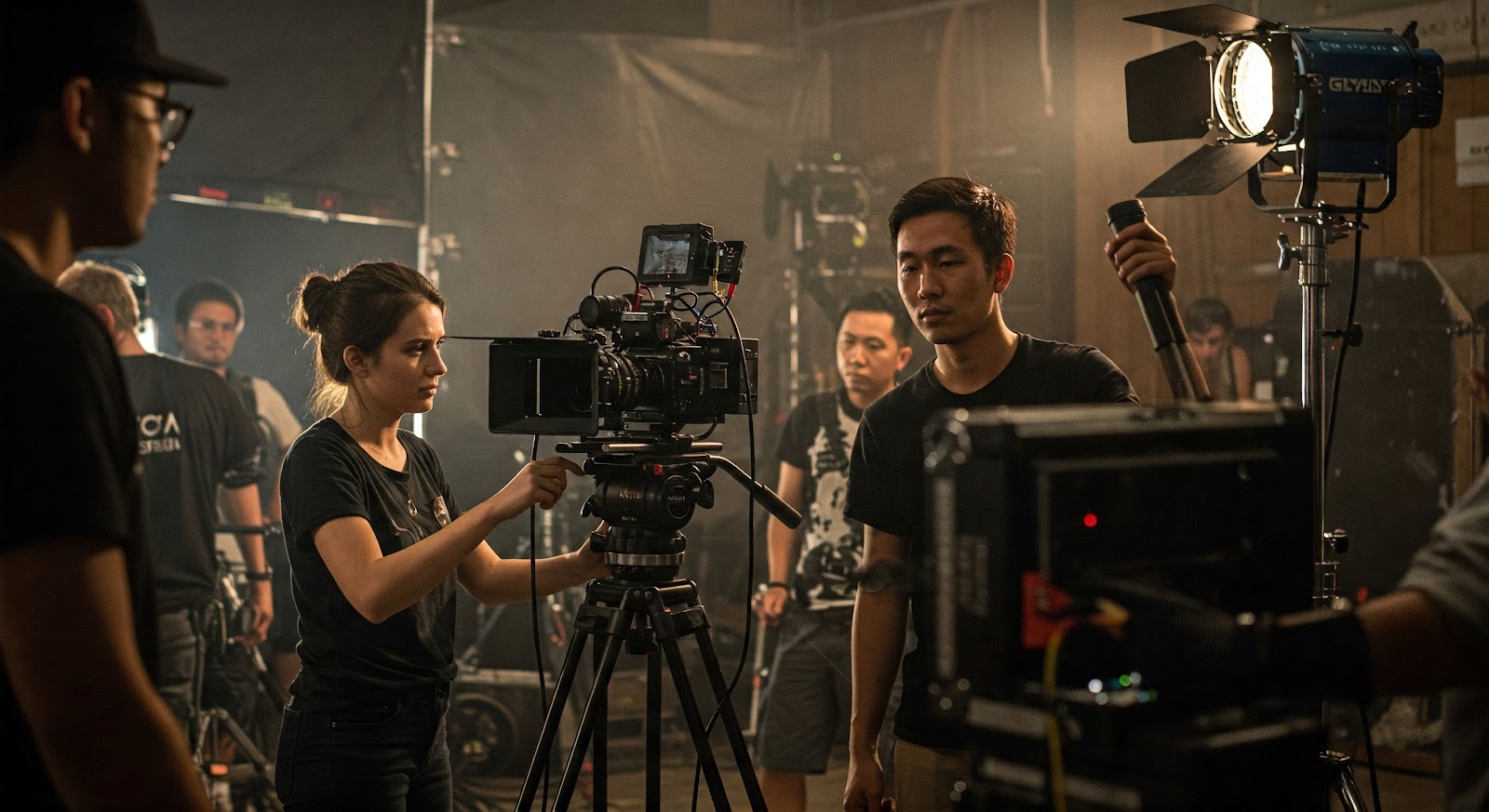From Script to Screen: The Video Production Process Behind Engaging Videos
In the digital age, video has become one of the most powerful tools in a brand’s arsenal to capture the audience’s attention. Whether you’re creating an explainer video, a promotional film, or a series of digital shorts for social media, the video production process is a strategic journey that involves creativity, structure, and technical finesse.
Video content is a leading method for conveying messages effectively, which helps to persuade viewers and ultimately results in higher conversion rates compared to other content forms.
This blog post walks through each stage of that journey—from concept and scripting to the final edit—shedding light on how engaging video content is created to captivate your target audience.
Introduction to Digital Video
In today’s fast-paced digital landscape, digital video has emerged as a cornerstone of modern marketing and communication. It offers businesses a dynamic way to convey complex ideas and emotions, creating an engaging and immersive experience for their audience. The process of creating digital video content involves several key stages, including pre-production, production, and post-production, each playing a vital role in bringing a concept to life.
Understanding your target audience is crucial for creating effective digital video content. By tailoring your message and style to resonate with your intended audience, you can ensure that your video content hits the mark. Digital video can take many forms, from explainer videos and animated videos to live-action films, each with its unique characteristics and advantages.
The rise of digital video has democratized the creative process, allowing businesses and individuals to produce high-quality video content without needing extensive resources or expertise. Video marketing has become a key component of any successful marketing strategy, enabling businesses to connect with their audience on a deeper level and convey their message in a more engaging and memorable way.
Creating video content requires a deep understanding of the audience’s needs and preferences, as well as the ability to craft a compelling narrative that resonates with them. The use of digital video in marketing and communication is continually evolving, with new technologies and platforms emerging all the time. These advancements offer new opportunities for video creators to reach and engage with their audience in innovative ways.
Understanding the Video Production Process
The video production process is divided into three key stages: pre-production, production, and post-production. Each phase plays a crucial role in transforming a concept into a compelling visual narrative that resonates with viewers and meets your marketing goals. Measuring the performance of video projects during these stages is essential to ensure optimization and achieve the desired impact.
1. Pre-Production Phase: Planning the Foundation
The pre-production phase is where the groundwork for successful video storytelling is laid. It includes everything that happens before the cameras start rolling. The context in which a marketing video is presented is crucial, as factors like video length and storytelling can significantly impact engagement.
Key tasks in this phase include:
- Video planning and goal setting
- Defining the target audience and intended message
- Scripting and storyboarding
- Determining the video format (live-action, animated video, explainer video, etc.)
- Selecting locations, actors, and props
- Assembling the production team
Sharing video scripts with team members or clients to gather their feedback is essential for refining the content and ensuring it resonates with the audience.
Strong pre-production ensures the project stays on time and within budget. It’s also where the creative direction takes shape, establishing tone, style, and visuals that move the story forward.
2. Scriptwriting: Crafting the Core Narrative
A well-written script is at the heart of every great video. It sets the structure, outlines dialogue, and highlights visual cues. This stage focuses on clarity, tone, and pacing, ensuring that the content connects with the audience.
Examples of successful video productions often illustrate the impact of storytelling in engaging audiences, showcasing how different styles and complexities influence emotional connections.
Good scriptwriting:
- Establishes a clear beginning, middle, and end
- Maintains narrative flow and consistency
- Communicates the brand’s message and values
- Keeps the audience’s attention throughout
Whether you’re creating longer videos for YouTube or short clips for ads, the script must guide the viewer and evoke an emotional connection.
3. Production Phase: Bringing the Script to Life
During the production phase, the video creators take the script and start the shoot. This is where the creative vision begins to materialize.
Shooting involves meticulous planning and execution to ensure every aspect of the video aligns with the intended vision.
In this phase, the production team focuses on:
- Setting up camera angles and lighting
- Directing talent and real people in action
- Capturing multiple takes for editing flexibility
- Recording ambient sound and dialogue
A well-planned shot list is crucial to ensure that every shot contributes effectively to the storytelling.
Production may involve using animations, stock images, or graphics to visualize complex ideas. The goal is to gather all necessary footage and audio to construct the story during editing. Proper color correction and grading may be necessary to harmonize the appearance across multiple shots.
4. Post-Production: Shaping the Final Story
Post production is where the magic truly happens. This stage involves editing all raw footage into a polished, cohesive video that matches the script and creative vision. Measuring the performance of the video during this stage is crucial to ensure it meets quality and impact standards.
Tasks include:
- Cutting clips together to create seamless flow
- Adding sound effects, voiceovers, and music
- Enhancing visuals through color correction, filters, and color palette adjustments
- Incorporating graphics, animations, and images to support the message
- Exporting the final video for multiple platforms
The post production team works closely with stakeholders to ensure the video is on-brand, effective, and ready for distribution. Cloud-based tools and cloud storage allow teams to collaborate remotely and manage assets efficiently.
Explainer Video Production: Simplifying Complex Ideas
Explainer videos are a powerful type of digital video content designed to simplify complex ideas and concepts, making them more accessible to the target audience. The production of explainer videos typically involves a combination of animation, graphics, and narration, which work together to convey the message clearly and concisely.
The key to creating effective explainer videos is to focus on the core message and avoid unnecessary complexity. Using simple language and visuals helps to get the point across without overwhelming the viewer. Explainer videos can be used in various contexts, including marketing, education, and training, providing an engaging and memorable way to communicate complex ideas.
Animation and graphics play a crucial role in explainer videos, helping to illustrate complex concepts and make them more engaging and interactive. This approach increases the audience’s understanding and retention of the information. When producing explainer videos, it’s essential to consider the audience’s needs and preferences, as well as the overall marketing strategy and goals of the business.
Explainer videos can be a powerful tool for businesses looking to communicate complex ideas in a simple and engaging way. They can support a range of marketing and communication objectives, creating a more interactive experience for the audience and increasing the chances of conveying the message effectively.
Creative Elements That Make a Video Engaging
Creating video content that captures audiences’ attention and drives engagement means leveraging creative tools and techniques.
Achieving success in video production requires a strategic approach to storytelling and the effective use of various creative elements.
Here are a few core elements:
- Video storytelling: Focused, authentic narratives that connect emotionally
- Sound design: Clear voiceovers, ambient sound, and on-brand music
- Visual style: Cohesive color schemes, consistent framing, and high production value
- Graphics and animations: Used to illustrate key points or simplify complex ideas
Each of these elements contributes to how the video appears to the viewer—whether it feels polished and professional or disjointed and unclear.
Techniques for Effective Video Content
Creating effective video content requires a range of techniques and strategies, including meticulous planning, scripting, and storytelling. The use of camera angles, lighting, and sound effects can significantly contribute to the overall mood and atmosphere of the video, helping to engage the audience from start to finish.
Understanding the audience’s attention span and preferences is crucial for creating effective video content. This knowledge enables video creators to tailor the length, style, and tone of the video to meet the audience’s needs. The use of color correction and a consistent color palette can help create a cohesive and engaging visual style, conveying emotions and setting the mood.
When creating video content, it’s essential to consider the overall marketing strategy and goals of the business. The use of music and narration can add depth and emotion to the video, helping to convey the message and engage the audience on a deeper level. Editing is a critical stage of the video production process, allowing video creators to refine the narrative, pace, and tone of the video to ensure it meets the audience’s expectations.
By employing a range of techniques and strategies, video creators can produce high-quality video content that engages, informs, and persuades the target audience. This approach helps achieve the marketing and communication objectives of the business, ensuring that the video content resonates with viewers and drives real-world results.
Tailoring Content to Your Target Audience
Understanding your target audiences is essential. Different demographics respond to different tones, formats, and lengths. The intended audience will influence every decision—from scriptwriting to video format selection to distribution channels.
For example:
- Explainer videos work well for introducing new services or products
- Animated videos can simplify abstract concepts
- Feature film-style brand stories can elevate a premium identity
Always align your content with your broader marketing strategy, ensuring the video supports business objectives like brand awareness, customer retention, or lead generation.
Distribution: Maximizing Reach and Impact
Once the final video is approved, it’s time to create videos for distribution across multiple channels. These might include:
- Your website
- YouTube and other digital video platforms
- Email campaigns
- Social media
Understanding the context in which the video will be viewed is essential, as it can significantly enhance the impact of your video marketing efforts.
Each platform has unique specs and best practices, so tailoring the video format accordingly is crucial. A thoughtful rollout plan helps your content stand out and reach potential customers where they already spend time.
Why the Process Matters
A streamlined, intentional video production process isn’t just about quality—it’s about clarity, consistency, and effectiveness. Videos that result from a thorough creative process make a stronger impact, earn more views, and contribute meaningfully to your marketing goals.
The success of well-produced videos lies in their ability to harness effective video storytelling, leading to significant marketing benefits and heightened brand recognition.
Engaging videos don’t just happen. They’re planned, written, filmed, and edited with intention and artistry.
Whether you’re a content creator, a small business owner, or a large enterprise marketing team, investing in a structured workflow from script to screen will elevate your storytelling, connect with your audience, and drive real-world results.
Ready to turn your next idea into an impactful video? Work with professional video creators who understand every step of the process—and who know how to make your story shine.




